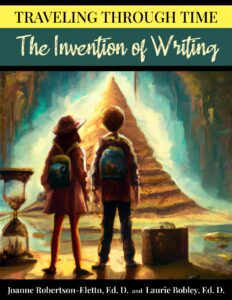
Dear Readers,
I am pleased to say that our new book has been well received by young readers, and the next book “Who Was the First Fashionista?” is in process! I plan to pilot projects with middle school students in the fall of 2024.
I was so appreciative of the National Council of Teachers of English (NCTE) Position Statement about using nonfiction literature. It has been described as a “game changer.”
“A game changer!” Dive Into the NCTE’s Position Statement on the Role of Nonfiction Literature
In addition, in a recent webinar, “From Facts to Fascination: Using Nonfiction to Drive Curriculum and Enthusiasm”,” the International Reading Association presented ways to discover new, high-quality nonfiction to teach content area curriculum and meet teachers’ /students’ instructional needs.
To that end, I have included an excerpt from our book to share what Laurie Bobley and my research-based approach presented in our book.
AUTHORS’ NOTE TO TEACHERS AND PARENTS
The 3Cs of our instructional approach are curiosity, connections, and comprehension.In this book, we capitalize upon students’ natural curiosity, sense of adventure, and vivid imaginations to spark and sustain their excitement from the very first page. We address
readers as “Time Travelers,” provide them with a mission to accomplish, and encourage self-exploration by providing tons of resources to assist them in their quest. We believe that a true understanding of History or Social Studies comes from knowing about the people who lived it. Therefore, we must saturate our students with the sights, sounds, emotions, and worlds of the people they are learning about. In doing so, they will
make connections to their own lives, dreams, and hopes. Without these connections, there can be no comprehension. Without comprehension, there can be no critical thinking
Multimodal and Experiential Learning
There is a growing body of educational research that supports the use of multimodal and experiential learning to enhance student engagement and improve learning outcomes.Studies have shown that when students are given the opportunity to engage with material through multiple modalities (such as reading, writing, listening, visualizing, and creating), they are better able to retain information and transfer this knowledge to new learning
contexts and tasks.
An example of experiential learning in our book is the use of time travel scenarios that allow students to explore historical events and times from a first-person perspective. To discover who invented writing, they are asked to go back to ancient times such as the Paleolithic, Egyptian, or Mesopotamian. Once there, they interactively explore cave
paintings, pictographs, hieroglyphics, and other writing systems, using technology, virtual tours, and resources to support and extend their growing understandings. They create timelines, writing samples, and projects that reflect what they have learned. They are
active participants throughout the reading, researching, writing, and creation process. They can use their smartphones to access QR codes, or if reading an e-book, they can just click the links to continue researching topics in which they are interested.
Fact-Based Stories
The fact-based stories in the book will captivate the imaginations of readers in grades 5-9 and motivate them to want to read more. The stories use authentic and accurate historical events, people, and places as inspiration, as well as research, primary sources, and other forms of factual evidence.
One of the benefits of fact-based stories is that they can be highly effective in engaging readers and promoting understanding of complex topics. By presenting factual information in a story format, readers are able to connect with the information on a more personal and emotional level, making it easier to remember and apply in real-world situations. For students whose heritage language is not English, these stories support the
understanding of content-specific vocabulary and unfamiliar concepts found in social studies and history texts. For gifted students, the text provides opportunities for them to explore topics and time periods in greater depth. For all students, the text allows for personal choice and decision-making about the text, tasks, and projects.
(My gifted fourth grade granddaughter Stassi preparing her cuneiform tablet dough).
Importance of Reading Nonfiction
There is a greater emphasis upon reading nonfiction in schools today.
There are many valid reasons for this, including the following:
• Reading nonfiction develops critical thinking skills.
It requires students to think critically about the information presented in the text.They must analyze, evaluate, and interpret the information in order to understand it and apply it to real-world situations.
• Reading nonfiction increases knowledge and understanding
It provides valuable information on a wide range of topics, from science and history to politics and social issues. By reading nonfiction, students can expand their knowledge and gain a deeper understanding of the world around them.
• Reading nonfiction improves reading comprehension.
Nonfiction contains content-specific vocabulary and varied sentence structures,which challenge students to improve their reading comprehension skills. By reading nonfiction regularly, students can improve their ability to understand and
analyze complex texts.
• Reading nonfiction prepares students for college and career.
Students who are proficient in reading and understanding nonfiction texts will be better prepared for the academic and professional challenges that lie ahead.
• Reading nonfiction promotes lifelong learning, which in turn provides
ongoing opportunities for personal growth and development.
By cultivating a love of nonfiction reading in the middle school years, students are more likely to continue reading and learning throughout their lives.
All the best,
Joanne Robertson-Eletto
